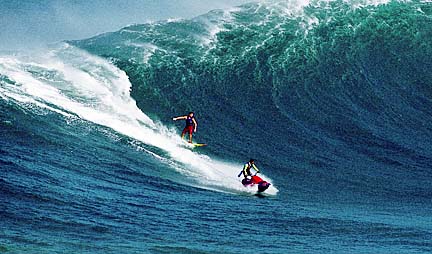


|
State Land Board Big-wave surfer Ken Bradshaw wants to expand options for tow-in surfers while making sure that people on personal watercraft do not make life dangerous for traditional surfers.
approves draft rules
for motorized
tow-in surfing
Personal watercraft are used to
accelerate surfers into big wavesBy Diana Leone
dleone@starbulletin.com"We're concerned not with proven watermen and expert wave-riders, but for those who will follow us," Bradshaw told the Board of Land & Natural Resources yesterday.
Bradshaw has been instrumental in developing proposed rules that would spell out where and how tow-in surfers will be allowed to practice their sport in Hawaii.
The board approved draft rules yesterday, with plans to hold public hearings on tow-in surfing rules later this year.
Tow-in surfers use a personal watercraft to pull a surfer into waves that are bigger than what can be caught by traditional paddling. The sport is done in pairs, with one person towing and lifeguarding while the other surfs, then trading places.
The gentlemen's agreement is that tow-in surfers should not go where there are paddle-in surfers. It is kind of like cars yielding the right of way to slower-moving pedestrians, Bradshaw said. But as more people take up the sport, conflicts are coming up.
Some people are ignoring the existing ban on personal watercraft in Ocean Recreation Management Areas, which extend 3,000 feet seaward from designated shores.
Bradshaw is seeking permission for tow-in surfers to be allowed to surf the outer reefs of these management areas, but only when there are high surf conditions that keep most paddle-in surfers on shore.
Defining a way for tow-in surfers to use these now-forbidden areas without conflicts with traditional surfers is a balancing act.
"The minute you start getting cowboys on the inside reefs, the whole thing is gonna blow," board member Tim Johns said. "The whole idea is not to have surfers tow in even when it's 6 feet or 10 feet," but to the big waves that are inaccessible for traditional surfers.
Johns proposed that tow-in surfing within the Ocean Recreation Management Areas be allowed only when the National Weather Service has issued high-surf advisories or warnings.
Federal law mandates that personal watercraft operators stay 200 feet away from anyone in the water. But paddle-in surfers Jack Bredin and Jim Hayes told the board they would prefer the state start discussions at a 1,000-foot distance.
"It's best to err on the side of safety," Bredin said.
The draft rules would require that tow-in surfers:
>> Not hold the state liable or responsible for their actions.
>> Only use personal watercraft for tow-in surfing.
>> Register their personal watercraft with the state as a tow-in vessel.
>> Be trained in safe use of a personal watercraft in high surf.
>> Carry a two-way communication device, dive fins, a safety knife and rescue sled on the tow-in watercraft.
>> Carry at least $100,000 in liability insurance for the personal watercraft.
>> Yield right of way to all other boating or ocean recreation activities and stay a minimum of 1,000 feet from other surfers.
>> Tow in only one person at a time.